Instructions for Side by Side Printing
- Print the notecards
- Fold each page in half along the solid vertical line
- Cut out the notecards by cutting along each horizontal dotted line
- Optional: Glue, tape or staple the ends of each notecard together
Fat Seals
front 1 1) In cats, black fur color is caused by an X-linked allele; the other allele at this locus causes orange color. The heterozygote is tortoiseshell. What kinds of offspring would you expect from the cross of a black female and an orange male?
| back 1 ✅ Answer: tortoiseshell females; black males |
front 2 2) Red-green color blindness is a sex-linked recessive trait in humans. Two people with normal color vision have a color-blind son. What are the genotypes of the parents?
| back 2 ✅ Answer: XᴺXⁿ and XᴺY |
front 3
| back 3 ✅ Answer: One-half of the daughters of an affected father and a carrier mother could have this condition. |
front 4 4) Glucose-6-phosphate dehydrogenase deficiency (G6PD) is inherited as a recessive allele of an X-linked gene in humans. A woman whose father suffered from G6PD marries a normal man. What proportion of their sons is expected to be G6PD? If the husband was not normal but was G6PD deficient, would you change your answer in part (a)?
| back 4 ✅ Answer: (a) 1/2; (b) no |
front 5 5) If cell X enters meiosis, and nondisjunction of one chromosome occurs in one of its daughter cells during meiosis II, what will be the result at the completion of meiosis?
| back 5 ✅ Answer: 1/4 of the gametes descended from cell X will be n + 1, 1/4 will be n - 1, and 1/2 will be n. |
front 6 6) One possible result of chromosomal breakage is for a fragment to join a nonhomologous chromosome. What is this alteration called?
| back 6 ✅ Answer: translocation |
front 7 7) Of the following human aneuploidies, which is the one that generally has the most severe impact on the health of the individual?
| back 7 ✅ Answer: trisomy 21 |
front 8 8) A phenotypically normal prospective couple seeks genetic counseling because the man knows that he has a translocation of a portion of his chromosome 4 that has been exchanged with a portion of his chromosome 12. Although his translocation is balanced, he and his wife want to know the probability that his sperm will be abnormal. What is your prognosis regarding his sperm?
| back 8 ✅ Answer: 1/4 will carry the two normal chromosomes, 4 and 12, 1/4 will have only the two translocation chromosomes and no normal chromosomes 4 and 12, and 1/2 will have both normal and translocated chromosomes. |
front 9 9) Abnormal chromosomes are frequently found in malignant tumors. Errors such as translocations may place a gene in close proximity to different control regions than normal. Which of the following might then occur to make the cancer worse?
| back 9 ✅ Answer: expression of inappropriate gene products |
front 10 10) A couple has a child with Down syndrome.The mother is 39 years old at the time of delivery. Which of the following is the most probable cause of the child's condition?
| back 10 ✅ Answer: The mother most likely underwent nondisjunction during gamete production. |
front 11 1)A possible sequence of nucleotides in the template strand of Dna that would cide for the polypeptide sequence phe-leu-ile-val would be ___.
| back 11 ✅ Answer: 3' AAA-AAT-ATA-ACA 5' |
front 12 2) What amino acid sequence will be generated, based on the following mRNA codon sequence? 5' AUG-UCU-UCG-UUA-UCC-UUG 3'
| back 12 ✅ Answer: met-ser-ser-leu-ser-leu |
front 13 3) Refer to the figure above. What would the anticodon be for a tRNA that transports phenylalanine to a ribosome?
| back 13 ✅ Answer: AAA |
front 14 4) In the process of transcription,___.
| back 14 ✅ Answer: RNA is synthesized |
front 15 5) What does it mean when we say the genetic code is redundant?
| back 15 ✅ Answer: More than one codon can specify the addition of the same amino acid |
front 16 6) Once researchers identified DNA as the unit of inheritance, they asked how information was transferred from the DNA in the nucleus to the site of protein synthesis in the cytoplasm. What is the mechanism of information transfer in eukaryotes?
| back 16 ✅ Answer: Messenger RNA is transcribed from a single gene and transfers information from the DNA in the nucleus to the cytoplasm, where protein synthesis takes place. |
front 17 7)According to the central dogma, what molecule should go in the blank? DNA → _ → Proteins
| back 17 ✅ Answer: mRNA |
front 18 8) Which of the following occurs in prokaryotes but not in eukaryotes?
| back 18 ✅ Answer: simultaneous transcription and translation |
front 19 9) Which of the following best describes the significance of the TATA box in eukaryotic promoters?
| back 19 ✅ Answer: It is the recognition site for transcription factors and RNA polymerase |
front 20 10) Alternative RNA splicing___.
| back 20 ✅ Answer: can allow the production of proteins of different sizes and functions from a single mRNA |
front 21 11) In an experimental situation, a student researcher inserts an mRNA molecule into a eukaryotic cell after she has removed its 5' cap and poly-A tail. Which of the following would you expect her to find?
| back 21 ✅ Answer: The molecule is digested by enzymes because it is not protected at the 5' end. |
front 22 12) Which one of the following statements about RNA processing is true?
| back 22 ✅ Answer: Splicesomes may function in RNA splicing. |
front 23 13) A primary transcript in the nucleus of a eukaryotic cell is___ the functional mRNA, while a primary transcript in a prokaryotic cell is___the functional mRNA.
| back 23 ✅ Answer: larger than; the same size as |
front 24 14) Translation requires
| back 24 ✅ Answer: mRNA, tRNA, and rRNA |
front 25 15) How does termination of translation take place?
| back 25 ✅ Answer: A stop codon is reached. |
front 26 16) Which of the following types of mutation, resulting in an error in the mRNA just after the AUG start of translation, is likely to have the most serious effect on the polypeptide products?
| back 26 ✅ Answer: a deletion of two nucleotides |
front 27 17) A nonsense mutation in a gene___.
| back 27 ✅ Answer: introduces a premature stop codon into the mRNA |
front 28 18) How might a single base substitution in the sequence of a gene affect the amino acid sequence of a protein encoded by the gene, and why?
| back 28 ✅ Answer: Only a single amino acid could change, because the reading frame is unaffected. |
front 29 19) An original section of DNA has the base sequence AGCGTTACCGT. A mutation in this DNA stand results in the base sequence AGGCGTTACCGT. This change represents___.
| back 29 ✅ Answer: Frameshift mutation |
front 30 20) Rank the following one base point mutations from most likely to least likely with respect to their likehood of affecting the structure of the corresponding polypeptide
| back 30 ✅ Answer: 4, 3, 2, 1 |
front 31 1) Prior to the work of Lyell and Darwin, the prevailing belief was that Earth is
| back 31 A1: A few thousand years old, and populations are unchanging |
front 32 2) During a study session about evolution, one of your fellow students remarks, "The giraffe stretched its neck while reaching for higher leaves; its offspring inherited longer necks as a result." Which statement is most likely to be helpful in correcting this student's misconception?
| back 32 A2: Characteristics acquired during life are generally not passed on through genes. |
front 33 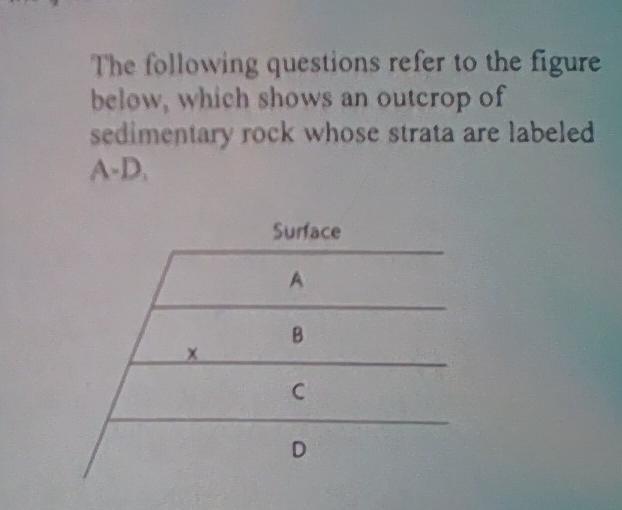 3) If x indicates the location of fossils of two closely related species, then fossils of their most-recent common ancestor are most likely to occur in which stratum?
| back 33 A3: Stratum C |
front 34 4) Which of these conditions are always true of populations evolving due to natural selection? Condition 1: The population must vary in traits that are heritable. Condition 2: Some heritable traits must increase reproductive success. Condition 3: Individuals pass on most traits that they acquire during their lifetime.
| back 34 A4: Conditions 1 and 2 (Heritable variation; Some traits improve reproductive success) |
front 35 5) A farmer uses triazine herbicide to control pigweed in his field. For the first few years, the triazine works well and almost all the pigweed dies; but after several years, the farmer sees more and more pigweed. Which of these explanations best explains what happened?
| back 35 A5: Triazine-resistant weeds were more likely to survive and reproduce. |
front 36 6) A biologist studied a population of squirrels for fifteen years. During that time, the population was never fewer than thirty squirrels and never more than forty-five. Her data showed that over half of the squirrels born did not survive to reproduce, because of both competition for food and predation. In a single generation, 90% of the squirrels that were born lived to reproduce, and the population increased to eighty. Which inference(s) about this most recent surge in the population size might be true?
| back 36 A6: Food availability may have increased and/or predators decreased. |
front 37 7) Which of the following must exist in a population before natural selection can act upon that population?
| back 37 A7: Genetic variation among individuals |
front 38 8) Which of Darwin's ideas had the strongest connection to his reading of Malthus's essay on human population growth?
| back 38 A8: Struggle for existence |
front 39 9) If Darwin had been aware of genes and their typical mode of transmission to subsequent generations, with which statement would he most likely have been in agreement?
| back 39 A9: Natural selection can change gene frequency enough to produce new species over time. |
front 40 10) Many crustaceans (for example, lobsters, shrimp, and crayfish) use their tails to swim, but crabs have reduced tails that curl under their shells and are not used in swimming. This is an example of___.
| back 40 A10: A vestigial trait |
front 41 11) If the bacterium Staphylococcus aureus experiences a cost for maintaining one or more antibiotic-resistance genes, what would happen in environments that lack antibiotics?
| back 41 A11: Bacteria with resistance genes are outcompeted by those without them. |
front 42 12) Of the following anatomical structures, which is homologous to the bones in the wing of a bird?
| back 42 A12: Bones in the flipper of a whale |
front 43 13) Over long periods of time, many cave-dwelling organisms have lost their eyes. Tapeworms have lost their digestive systems. Whales have lost their hind limbs. How can natural selection account for these losses?
| back 43 A13: These structures became costly and provided no advantage in certain environments. |
front 44 14) Which of the following evidence most strongly supports the common origin of all life on Earth? All organisms
| back 44 A14: All organisms use essentially the same genetic code. |
front 45 15) Members of two different species possess a similar-looking structure that they use in a similar way to perform about the same function. Which of the following would suggest that the relationship more likely represents homology instead of convergent evolution?
| back 45 A15: They share many proteins and nearly identical nucleotide sequences. |
front 46 16) It has been observed that organisms on islands are different from, but closely related to, similar forms found on the nearest continent. This is taken as evidence that___.
| back 46 A16: Island forms are descended from mainland forms. |
front 47 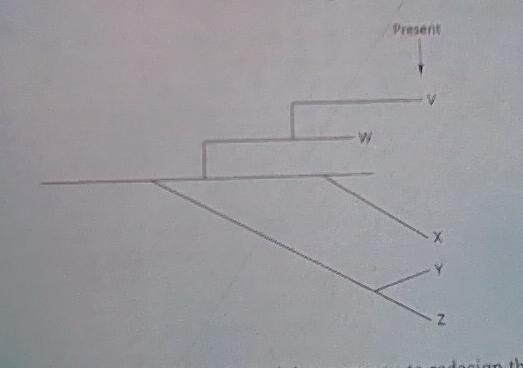 17) Which of the following might cause you to redesign this evolutionary tree?
| back 47 A17: DNA sequence relationships don’t match skeletal relationships. |
front 48 1) Which of the following choices includes all of the others in creating global terrestrial climates?
| back 48 A1: Differential heating of Earth's surface |
front 49 2) Why is the climate drier on the leeward (downwind) side of mountain ranges that are subjected to prevailing winds?
| back 49 A2: Air rises on the windward side, cools, and loses moisture; drier air descends on the leeward side. |
front 50 3) The main reason polar regions are cooler than the equator is that
| back 50 A3: Sunlight strikes the poles at an angle. |
front 51 4) Coral reefs can be found on the southeast coast of the United States but not at similar latitudes on the southwest coast. Differences in which of the following most likely account for this?
| back 51 A4: Ocean currents |
front 52 5) When climbing a mountain, we can observe transitions in biological communities that are analogous to the changes___.
| back 52 A5: Changes in biomes at different latitudes |
front 53 6) Which statement describes how climate might change if Earth was 75 percent land and 25 percent water?
| back 53 A6: Daytime temperatures would be higher and nighttime temperatures lower. |
front 54 7) If global warming continues at its present rate, which biomes will likely take the place of the coniferous forest (taiga)?
| back 54 A7: Temperate broadleaf forest and grassland |
front 55 12) In deep water, which of the following abiotic factors would most limit productivity (photosynthesis)?
| back 55 A12: Light availability |
front 56 13) Which of the following is the greatest physiological challenge for a fish swimming from a river into an estuary?
| back 56 A13: Change in water solute content affects osmotic balance. |
front 57 14) The oceans affect the biosphere by__ I producing a substantial amount of the biosphere's oxygen Il) adding carbon dioxide to the atmosphere III) being the source of most of Earth's rainfall
| back 57 A14: Only I, II, and III (Produce oxygen, add CO₂ to atmosphere, source of rainfall) |
front 58 Match the description with the structure:
Produces bile. Site of protein, carbohydrate and lipid digestion. Site of protein digestion, has a pH of 2. Site of carbohydrate digestion and mechanical digestion. Produces enzymes for protein, lipid and carbohydrate digestion. Site of nutrient absorption. Absorbs water and vitamins. Site where bile is stored and concentrated. Muscle that controls movement of food from between esophagus and stomach. Produce enzymes that partially break down carbohydrates. | back 58
|
front 59 Describe how insulin and glucagon work as a pair to control blood glucose levels and maintain homeostasis. Use the following answer options:
| back 59
25. This hormone raises blood glucose levels.
26. This hormone lowers blood glucose levels.
27. This hormone causes glycogen to be broken down into
glucose molecules and released into the bloodstream.
28. This hormone is necessary for cells to transport glucose
from the blood into the cell.
29. People who have type I diabetes are not producing this
hormone. |
front 60
| back 60 → kidney |
front 61 2 The function of the excretory system is to control homeostasis and
| back 61 removes waste |
front 62
| back 62 filters waste from the blood |
front 63
| back 63 removing carbon dioxide wastes from tissues |
front 64 5 Which are the components of the circulatory system?
| back 64 blood, blood vessels, and heart |
front 65
| back 65 systemic circulation |
front 66 7 Which is the correct direction of blood flow?
| back 66 → right atrium → right ventricle → pulmonary artery |
front 67 Compared with the walls of arteries, the walls of capillaries
| back 67 are thinner |
front 68
| back 68
|
front 69
10. Which type of blood vessel carries blood
away from the heart? | back 69 ✅ b. Arteries |
front 70
11. Which of the following is true about blood
pressure? | back 70 ✅ c. It is typically lower in veins than in arteries. |
front 71
12. Uncontrolled hypertension (high blood pressure)
can lead to: | back 71 ✅ d. All of the above |
front 72
13. The sudden death of brain cells when their blood
supply is interrupted is called: | back 72 ✅ b. A stroke |
front 73
14. Which of these structures provides the muscle
cells in the heart with a constant supply of oxygen? | back 73 ✅ a. Coronary arteries |
front 74
15. What structure serves as a passageway for both
air and food? | back 74 ✅ c. Pharynx |
front 75
16. Because there is more oxygen in an alveolus than
in the blood around it, oxygen diffuses: | back 75 ✅ b. From alveoli into capillaries |
front 76
17. When you take a deep breath, air is forced into
your lungs by the contraction of your: | back 76 ✅ c. Diaphragm |
front 77
18. How does movement of the rib cage change air
pressure in the chest cavity? | back 77 ✅ a. When the rib cage raises, a decrease in air pressure in the chest cavity causes air to rush into the lungs. |
front 78
19. How does tobacco smoke affect the body? | back 78 ✅ d. All of the above |
front 79 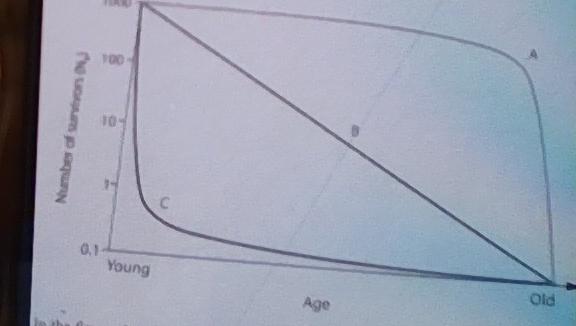
1) In the figure above, which of the following survivorship
curves implies that an animal may lay many eggs, of which a regular
number die each year? | back 79 Curve B |
front 80 
2) In the figure above, which of the survivorship curves most
applies to living in developed countries? | back 80 Curve A |
front 81 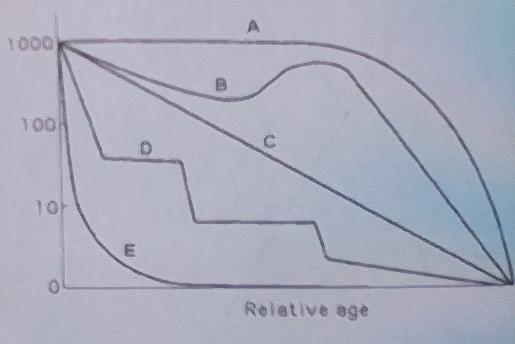
3) Refer to the figure above. Which curve best describes
survivorship in marine mollusks? | back 81 Curve C |
front 82 
4) Refer to the figure above. Which curve best describes
survivorship in elephants? | back 82 Curve A |
front 83 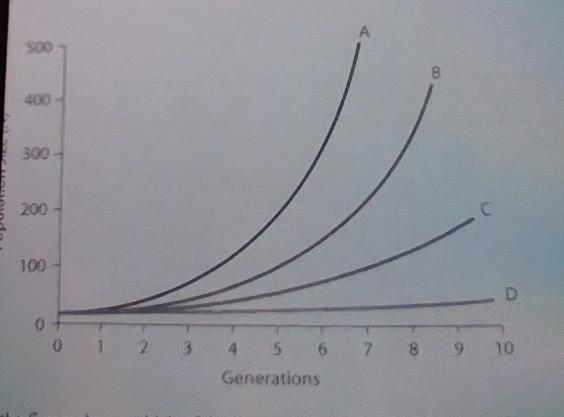
5) In the figure above, which of the lines represents the
highest per-capita rate increase (r)? | back 83 Line A |
front 84 The symbols +, –, and 0 are used to show the results of interactions between individuals or groups.
6) What interactions exist between a lion pride and a hyena
pack? | back 84 D) -/- |
front 85 The symbols +, –, and 0 are used to show the results of interactions between individuals or groups.
7) What interactions exist between a tick on a dog and the
dog? | back 85 C) – / + |
front 86
8) Which of the following statements is consistent with the
principle of competitive exclusion? | back 86 A) Even a slight reproductive advantage will eventually lead to the elimination of the less well-adapted of two competing species. |
front 87 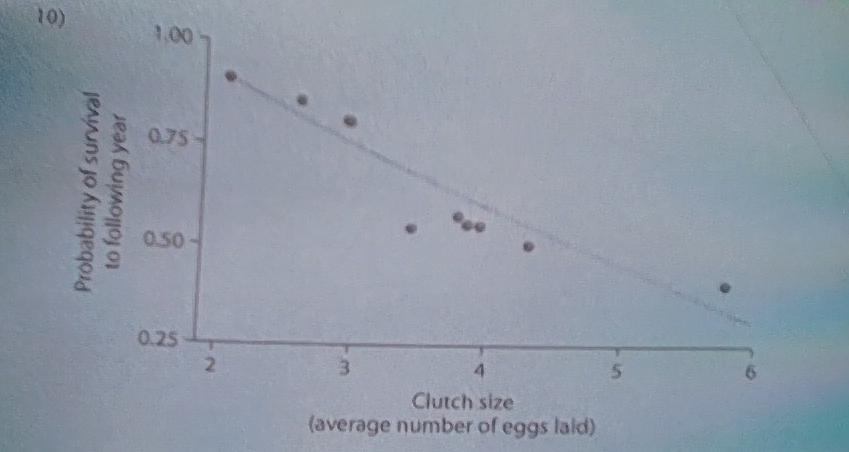
9) Looking at the data in the figure above, what can be said
about survival and clutch size? | back 87 ✅ D) Large clutch size correlates with low survival. |
front 88
10) You observe two female fish of the same species breeding.
One female lays 100 eggs and the other lays 1000 eggs. Which one of
the following is LEAST likely given the limits of fitness
trade-offs? | back 88 ✅ B) The eggs from the female laying 1000 eggs have larger yolks than the yolks of the eggs from the female laying 100 eggs. |
front 89
11) Which of the following is characteristic of
K-selected populations? | back 89 ✅ A) Offspring with good chances of survival |
front 90
12) In the global nitrogen cycle depicted in the figure above,
what is the limiting portion of the cycle for plants?
| back 90 B) Nitrogen fixation by bacteria |
front 91 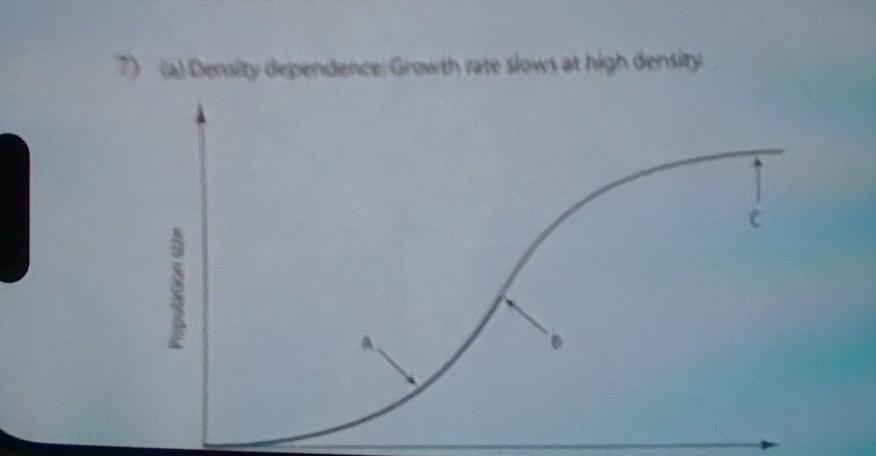
7) In the figure above, which of the arrows represents the
carrying capacity? | back 91 Arrow C |
front 92
8) As N (population size) approaches K (carrying capacity) for
a certain population, which of the following is predicted by the
logistic equation? | back 92 B) The growth rate will approach zero |
front 93
9) Which of the following causes populations to shift most
quickly from an exponential to a logistic population
growth? | back 93 C) Competition for resources |
front 94 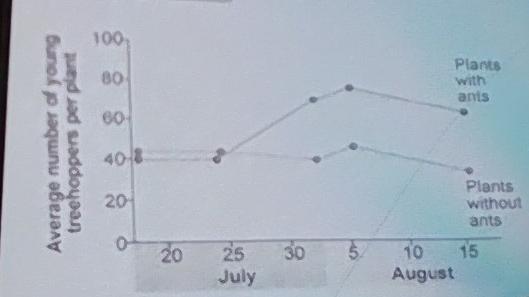
10) Treehoppers (a type of insect) produce honeydew, which
ants use for food. Treehoppers have a major predator, the jumping
spider. Researchers hypothesized that the ants would protect the
treehoppers from the spiders. In an experiment, researchers followed
study plots with ants removed from the system and compared them to a
control plot. In the figure above, what can you conclude?
| back 94 B) Ants do somehow protect the treehoppers from spiders |
front 95
11) Dwarf mistletoes are flowering plants that grow on certain
forest trees. They obtain nutrients and water from the vascular
tissues of the trees. The trees derive no known benefits from the
dwarf mistletoes. Which of the following best describes the
interactions between dwarf mistletoes and trees? | back 95 D) Parasitism |
front 96
12) In some circumstances, grasses benefit from being grazed.
Which of the following terms would best describe such a
plant-herbivore interaction? | back 96 C) Mutualism |
front 97
13) How does inefficient transfer of energy among trophic
levels result in the typically high endangerment status of many
top-level predators? | back 97 B) Top-level predators are destined to have small populations that are sparsely distributed. |
front 98
14) Why does a vegetarian leave a smaller ecological footprint
than an omnivore? | back 98 A) Eating meat is an inefficient way of acquiring photosynthetic productivity. |
front 99
15) For most terrestrial ecosystems, pyramids composed of
species abundances, biomass, and energy are similar in that they
have a broad base and a narrow top. The primary reason for this
pattern is that: | back 99 D) At each step, energy is lost from the system. |
front 100 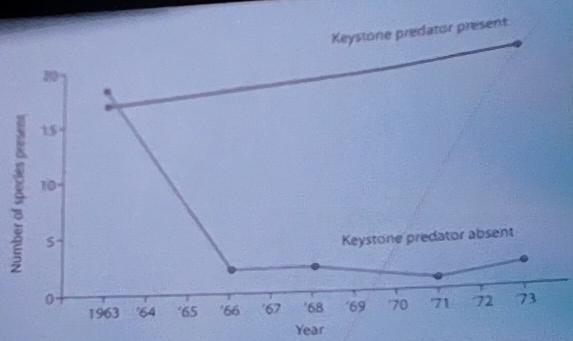
16) What does the graph in the figure above tell you about the
definition of a keystone species? | back 100 C) Removing a keystone species from the community drastically reduces diversity. |
front 101
17) Approximately how many kilograms (kg) of carnivore
(secondary consumer) biomass can be supported by a field plot
containing 1000 kg of plant material? | back 101 A) 10 |
front 102
18) In a tide pool, fifteen species of invertebrates were
reduced to eight after one species was removed. The species removed
was likely a(n): | back 102 A) Keystone species |
front 103 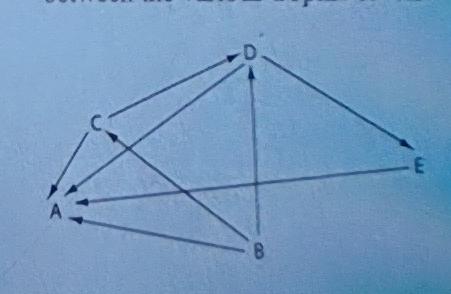
19) Use the following diagram of a hypothetical food web to
answer the question: Which letter represents an organism that could
be a producer? | back 103 A) B |